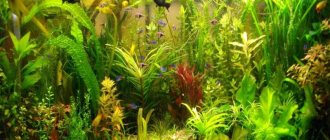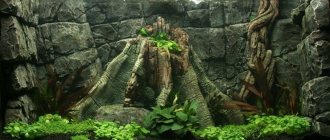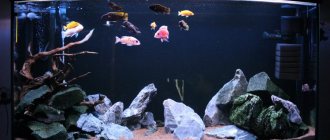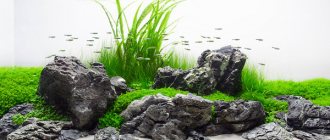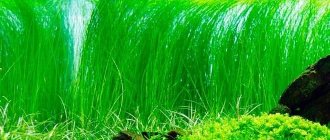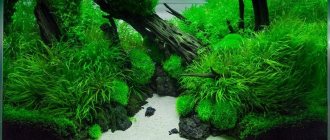An aquarium is a decoration for any interior. Today it is not just a vessel with fish, but a real work of art, which has been developed into a separate branch of the design direction with several stylistic types. The design of a modern aquarium includes various aquatic compositions of algae, stones, figures of ships and fish. Before you start decorating an aquarium with your own hands, you need to understand the basics of this art, choose the style in which the aqua design will be made, and stock up on the necessary tools.
You can put a piece of wood in the aquarium
You can stick a photo on the back of the aquarium
The bottom of the aquarium can be decorated with toys
Basic styles
Aquarium science distinguishes several types of aquarium design. But everyone is able to complement and improve aquadesign. Below are the main decorative styles for aquariums.
Dutch
This style first appeared in the middle of the last century and is still popular among aquascapers. The peculiarity of the Dutch style is the more, the better, or the complete filling of free space. This is especially true for the bottom part. Do not leave empty areas at the bottom. A large amount of vegetation of different levels is planted, the contrast of red and green colors is especially welcome. In the middle, attention is drawn to a snag or a structure made of large stones.
Pseudo-sea
Creating a pseudo-marine style does not require large investments. It requires standard soil and undemanding plants. The backlight is preferably blue. For additional resemblance to the sea, shells, artificial shells, and corals are used for the soil.
Natural
When using a natural style, it is important to create an interconnected and holistic composition of nature. There are several completed variations in the natural style:
- Rock garden. The main part of the decorations are stones. Sometimes stone figures have a hidden meaning.
- Iwagumi. Stones and Japanese dwarf trees are used, complemented by figures of houses, ships, and boats.
- Reboku. The focus is on driftwood and large stones.
- Wabi-kusa. A distinctive feature of this option is the presence of a moss hummock above the surface of the water. The plant that is used as tussock is called wabi-kusa, hence the name.
Techniques for creating underwater landscapes from famous masters
Experienced aquascapers use a lot of simple and more complex techniques when creating underwater compositions. They manage to give the completed landscape that same WOW effect, that is, to evoke in the viewer a feeling of admiration for the new reality built in an enclosed space.
Simple techniques for constructing landscapes can be used in aquascapes by both beginners and experienced aquarists to enhance visual perception.
- "Concave" shape
The arrangement and height of the planted vegetation is reduced to some central point at the bottom, so that the appearance of an open space in the middle is created.
- "Convex" composition
This type of plan is also called an island because the seaweed is cut lower on both sides and higher in the middle, which can be enhanced by the shape and direction of the stones.
- Aquascape in the shape of a triangle.
This technique creates a balanced visual image due to the fact that the height of the vegetation gradually decreases from the largest on one side of the aquarium to the smallest on the other.
- Illusion of depth
Natural aquariums sometimes have the effect of making the landscape appear larger (deeper) than it actually is. “Depth” is created by the following technique: first, the end point or viewpoint is determined. This is the main focal point of the landscape. - the place where the viewer first looks.
Then you need to place the substrate so that it is higher at the back and lower at the front. Small hardscape pieces are used at the back and large ones at the front. As a result, the contrast of sizes creates additional depth.
- Multi-layering
It also uses perspective for the “increasing depth” effect. Perspective adds depth to the rendered scene, and layering creates the illusion of three-dimensionality in the aquarium space.
General instructions for setting up an aquarium
When decorating an aquarium with your own hands, there are certain fundamental principles. The main one is that when decorating an aquarium, underwater pets are moved to a separate tank. This will help avoid injury, damage and stress to the fish. It is better to move the water along with the fish so that their body does not experience additional stress due to a sudden change in water. After decorating, pour water into the aquarium.
The second rule is mandatory disinfection of all new items with which the aquarium will be decorated. Even items that cannot be replaced are processed after some time.
Large stones
Decorating an aquarium with stones is the most common and convenient. Rocks not only decorate the aquarium, but are also used by fish as shelter and a place for spawning. Stones made of granite, gneiss, basalt, porphyry, and other rocks are suitable for an aquarium. Limestone, dolomite and sandstone stones can only be used for hard water aquariums. All large structures and stones are installed on the bottom before backfilling the main soil, and it is recommended to lay sheets of plastic under them to avoid damage to the bottom.
Decoration stages
Creating an aquarium design takes place in several stages and affects all areas.
Background
To decorate an aquarium, films or models made independently are used as a background. The right choice of background visually increases the space and creates the integrity of the underwater design.
Priming
For beginner aquarists, it is recommended to buy ready-made soil mixtures. When making soil yourself, it is difficult to take into account all the criteria, for example, particle size, color of the soil, what origin the soil is from. But when deciding to choose the soil yourself, take into account the type of fish and the general background of the aquarium.
How to choose a container for different rooms
The main rule of choice concerns the correspondence between the size of the artificial reservoir and the room in which it is planned to be installed. You cannot place a large aquarium in a small room. In this case, you can provide miniature options or objects of non-standard shape (for example, in the form of a column).
It is necessary to provide space for equipment (filter, cooler, etc.) in advance.
Consider also how well a particular model will fit into the design of the room. There are different decorating styles that may not suit any given room. If there is free space only in the window area, you should refuse to install the container in this room.
Fish and plants should not be exposed to direct sunlight as this will cause them serious harm.
Filling procedure
When decorating, there are several stages that are mandatory for anyone who decides to engage in aquascaping.
- Choose a design style or develop your own design.
- Buy selected items from a pet store.
- Treat stones and wooden parts if you choose them outdoors.
- Process purchased items.
- Fill up the soil.
- Arrange the decorative pieces.
- Secure the equipment.
- Plant plants if necessary.
- Fill with water.
- Add underwater inhabitants.
If you use sea corals to design an aquarium, they are placed in the aquarium only after all inhabitants have settled.
Aquascaping in 100 liters
This volume of the vessel expands the boundaries of creativity. Here you can use different aquarium plants, decorating it in the Dutch style, or use a minimum of elements and create aquascaping in the style of an Iwagumi or Zen garden.
You can put a small artificial castle on the bottom of the aquarium
Home aquarium design option
For example, decoration with Eleocharis sp. "Mini" will create a soft lawn that does not grow and does not require regular mowing. You can also supplement the aquarium with a couple of stones and a driftwood with moss in the form of a bonsai. To do this, you can use Java moss, which is unpretentious in cultivation, and the only requirement for full growth is an established carbon dioxide circulation system. In dim light, Java moss will have an oblong shape and a light shade; in bright light, its texture will be denser, and its shape will be more compact and neat.
An aquarium with algae and pieces of wood will look very beautiful
You can put stones in the aquarium
The aquarium can be built into the interior opening
See alsoBottle decor with ribbons - luxurious, ornate, unusual
Aquascaping Ideas
- An aquarium with large objects and large inhabitants.
- Minimalistic style.
- Using corals.
- Use of fluorescent parts.
- Create an opening in the wall.
For 50 liters
A small 50 liter freshwater aquarium will be a good preparation before purchasing larger tanks. It is easy to maintain such a volume; it is easier to provide the necessary conditions and install aeration and filtration systems. Slow-growing plants take root well in such a space, but it is not recommended to plant fast-growing ones; they require frequent pruning of overgrown parts. Not all types of fish can live in a space of 50 liters, only small and medium-sized ones. For example, swordtails, guppies, zebrafish, molynesias. Larger species will not have enough space.
What plants can be planted in a florarium?
Plants for a mini-greenhouse should be:
- small size (up to 20cm),
- with a poorly developed root system,
- with slow growth of stems and leaves.
Important : low-growing seasonal flowers and annual plants can be grown in a florarium.
Be sure to consider the plants' requirements for humidity, light and temperature. For ease of selection, bring a florarium container to the flower shop. When combining several seedlings, be sure to ensure their compatibility. The easiest way is to consult with a specialist, or purchase ready-made plant mixes for different microclimates.
Photo
Assembly
Degrease the surface to apply the sealant. Apply a thin bead of sealant around the edges of the glass. After this, join the glass using a metal corner, but do not press too hard.
Make small spacers from cardboard or a block of wood and clamp the whole thing with clamps. In total you will need 4 profiles and 8 clamps for all corners of the aquarium.
DIY fan: how to make a homemade powerful fan. Basic parameters and properties of fans (130 photos)- Why do you need a security alarm, what functions does it perform?
How to choose winter workwear and not make a mistake - recommendations from the pros
Do not forget that for normal living conditions for fish, it will be necessary to install an external filter for the aquarium and a pump so that the water does not stagnate.
How to decorate
Nowadays there are many possibilities for decorating an aquarium. Even the soil has turned into a decorative detail. However, let's consider everything in order.
Priming
You can prepare the soil for the aquarium yourself. Collect from the nearest area where there is suitable sand or beach and then sift using a sieve. Or you can buy it in one of the stores.
When selecting and purchasing, you must take into account that nutritious soils are on sale. They contain substances that enhance plant growth and give them a more impressive and healthy appearance. And there are decorative ones that are not suitable for plants.
Soils are made from the following materials:
- quartz;
- pebbles;
- sand;
- gravel;
- coral sand;
- artificial (plastic, glass, polymers).
In addition, soil particles differ in color (black, white, colored) and size.
For planting plants in decorative soils, a special nutrient litter is used.
Stones for decoration
Stones are considered the simplest and cheapest natural material. They are spectacular and are used as natural grottoes. However, not all selected cobblestones are suitable for decorating an aquarium with stones.
Hobbyists and experts select the following types of decorative elements:
- volcanic origin;
- marble, granite and their varieties;
- sea and river pebbles.
You don’t have to go to exotic countries to find volcanic stone. They have been successfully supplied to pet stores for a long time.
Also suitable:
- quartzite;
- amber;
- slate;
- porphyry;
- gneiss.
To decorate an aquarium with stones, it is not necessary to collect heavy cobblestones. There are light synthetic options. Fashionable are light ones, hanging in the water column, decorated with mosses and ferns. They are attached to the bottom and walls on a transparent fishing line of the required length.
driftwood
You can choose driftwood in the forest and prepare it yourself. The literature contains a description of how to select, boil and prepare driftwood for an aquarium. This is a very popular decorative element that adds some zest to the seascape. Some fish enjoy grinding down snags, adding variety to their diet.
But you can also buy it. The most popular is mangrove. This tree is popular because it does not rot, does not float, and has a beautiful structure and color. Harmless to fish.
Vegetation
Plants can be natural or artificial. If an aquarist prefers live plants, then he will have to master the secrets of growing, propagating and pruning them. Hobbyists, knowing the characteristics of their pets, create entire semi-flooded gardens.
But artificial vegetation is no worse and less capricious. It is better to give preference to well-established companies. They will last longer, look natural, and are harmless to animals.
For better plant growth, special fertilizers are used, which are added to the water and do not oppress the other inhabitants of the reservoir.
Back wall (background)
A decorative background creates the background of the aquarium. With a well-calculated design, the middle ground smoothly flows into the background, creates perspective and details the landscape.
The decorative background can be:
- Film glued to the outside of the back wall. The plots are very diverse. From underwater gardens to animated stories.
- Cork tiles.
- Plastic imitations.
- Volumetric backgrounds. They are attached from the inside of the vessel. But over time, they can pose a danger to fry, small fish and animals. The background peels off from the base, the animals get inside, cannot get out on their own and die. In addition, cheap plastic can release harmful substances into the water.
Other types of decor
In addition to the decorative elements described above, there are many more options.
Available for sale:
- Grottoes: barrels, flowerpots, vases, decorations-shelters with moss, minks, pots.
- Castles, fortresses, ships, anchors, artificial driftwood.
- Figurines: stars, octopuses, jellyfish, volcanoes, mushrooms, figurines.
To make your own decor, you can use regular foam.
Scheme of working with it:
- A castle, rock, stone is cut out of a piece of foam plastic.
- The front side is fired until small bubbles appear.
- While the surface is hot, cement, alabaster or gypsum is applied to it.
- Wait until the surface is completely dry and paint it with gold or gray paint.
- Attaches the front side to the aquarium.
Making “treasuries” from pebbles.
These interesting interior details can be made from ordinary pebbles picked up on the beach:
- Small stones of round shape and the same size are selected.
- The required drawing is selected in advance.
- The pebbles are glued together according to the pattern using silicone glue.
This is how caves, bridges, castles and fortresses are created. If it’s difficult to come up with the shape of an object yourself, then on the Internet you can always find an example of work and a step-by-step execution scheme. Glass beads are suitable for decoration. Some craftsmen even manage to make decorative pearls.


